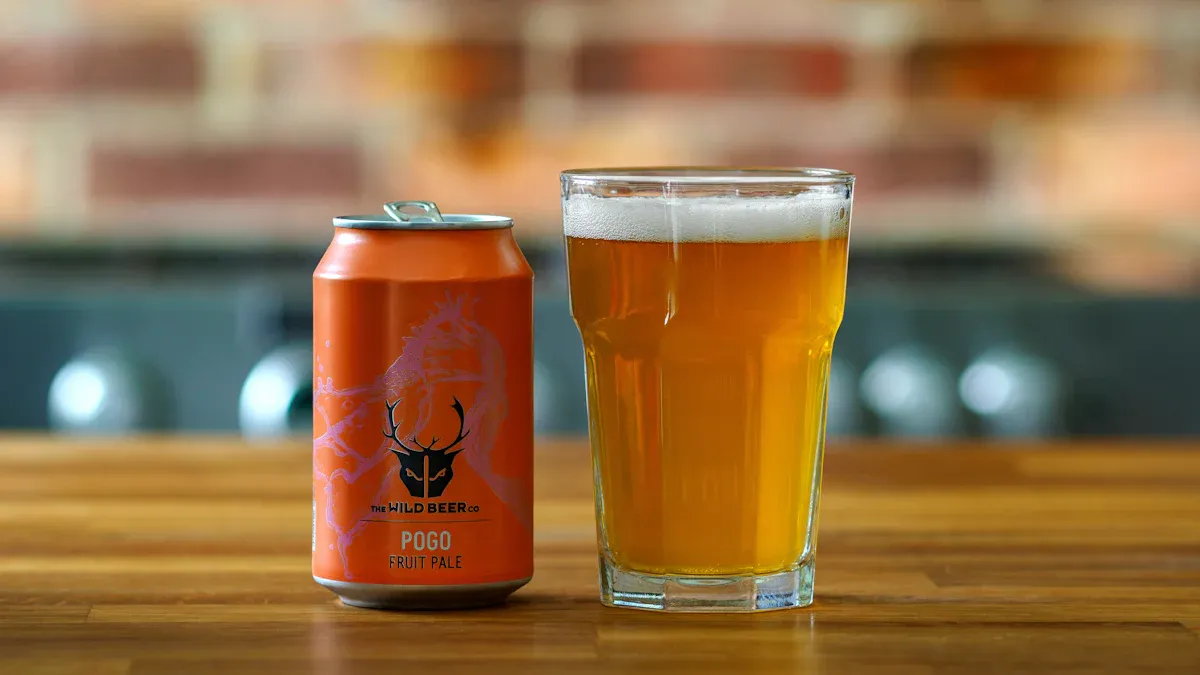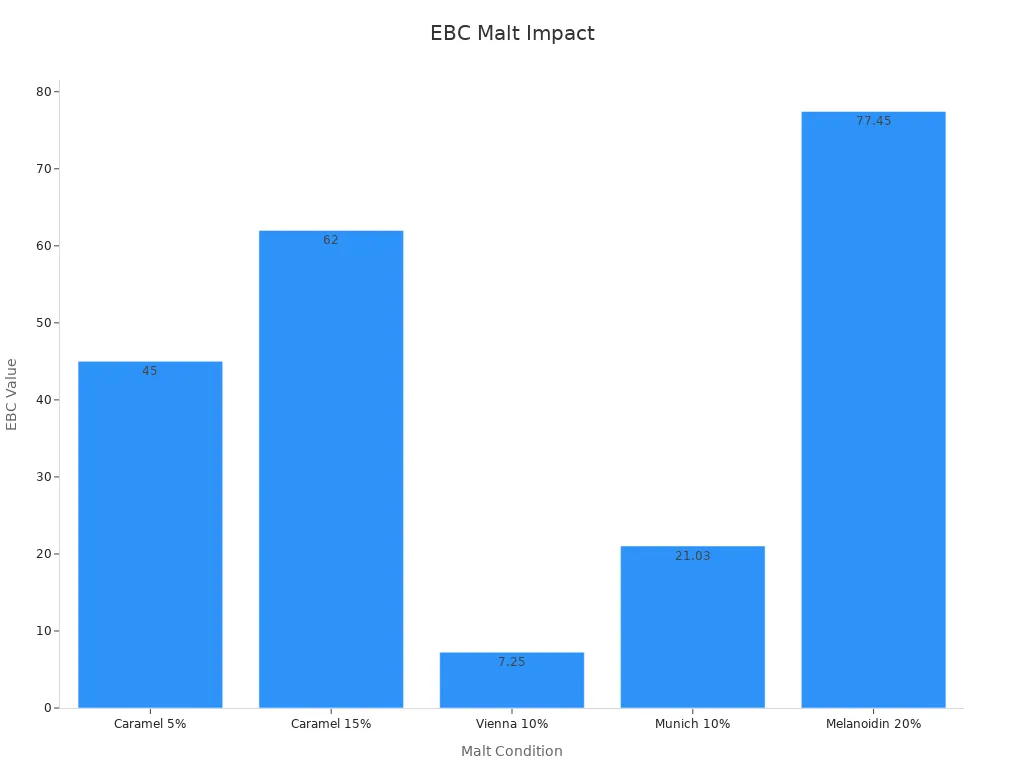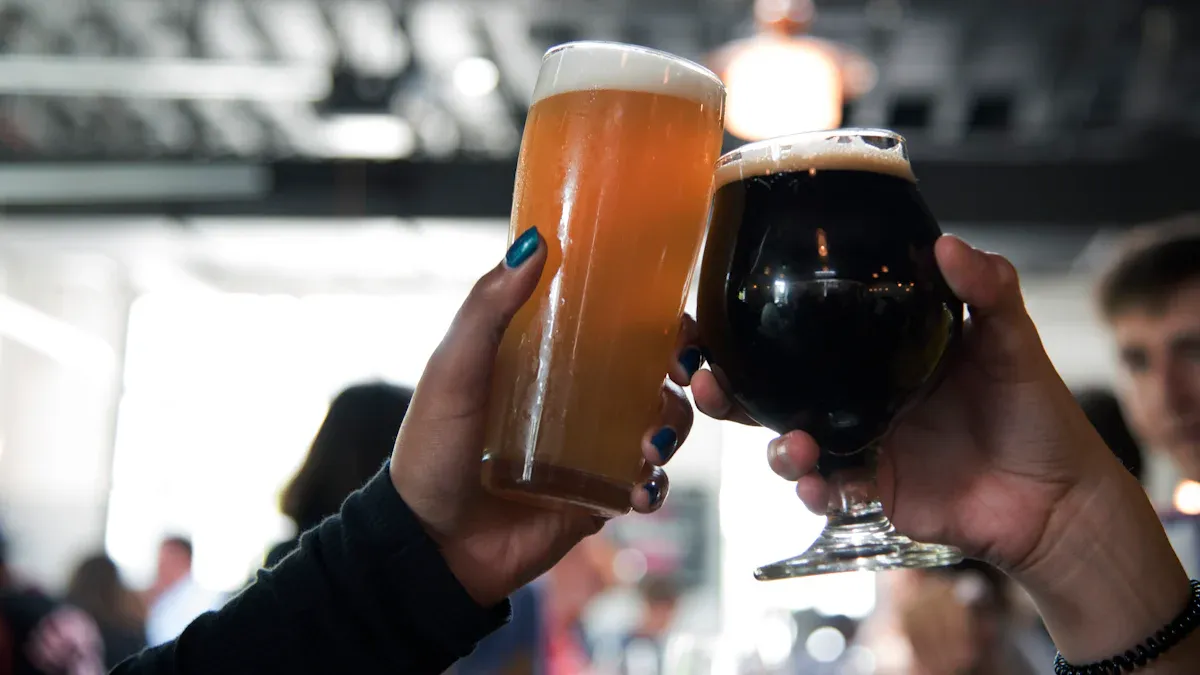
You can find many types of ale when you explore beer. These types of ale include pale ale, IPA, stout, porter, brown ale, wheat ale, sour ale, Belgian ale, barleywine, and imperial stout. Each type of ale has its own unique taste, color, and aroma. Some types of ale taste light and fresh, while others are rich, dark, or fruity. If you want to learn about beer, try different types of ale. You will discover how these types of ale differ from other beers.
Key Takeaways
Ales use top-fermenting yeast and warmer temperatures. This gives them strong, fruity flavors and many colors. Pale ales are popular because they taste balanced and mild. They also feel refreshing. IPAs have strong hop bitterness and taste like citrus or pine. Stouts and porters have rich, roasted flavors like coffee and chocolate. These are great for people who like dark, creamy beers. Brown ales taste smooth, nutty, and like caramel. They are easy to drink and good for people who like mild flavors. Trying different ales lets you find new flavors and styles. You can try tart sour ales, strong barleywines, or creamy wheat ales.
Types of Ale
![Types of Ale]()
Ales are different from other beers. They use top-fermenting yeast and warmer temperatures. This makes ales taste bold and gives them fruity smells. Ales also come in many colors. There are many types of ale. Each type has its own taste and style. Let’s learn about the main types of ale and what makes them special.
Pale Ale
Pale ale is a very popular type of ale. It has a golden or amber color. The taste is balanced with sweet malt and gentle hop bitterness. Pale ales feel crisp and refreshing. Many people who like beer enjoy pale ales.
Flavor: Mild, balanced, slightly fruity
Color: Light gold to amber
Aroma: Floral, sometimes citrusy
There are different styles of pale ale in the world. English pale ales have earthy hops and a smooth finish. American pale ales use more hops for a brighter, citrusy taste. Belgian pale ales are a bit sweeter and smell spicy.
Pale ale is a favorite for many people. In 2024, pale ale sales reached $32.5 billion. Experts think sales will keep growing. Surveys show that you and others like pale ales for their easy-drinking style and fresh taste.
IPA
India pale ales, or IPAs, are known for strong hop flavors and smells. When you drink an IPA, you taste pine, citrus, or tropical fruit. IPAs usually have more alcohol than other ales. They also taste more bitter.
Flavor: Strong hop bitterness, citrus, pine, or fruit
Color: Pale gold to deep amber
Aroma: Intense, hoppy, sometimes floral or fruity
There are many kinds of IPA. American IPAs have bright, citrusy hops. English IPAs taste earthier and are less bitter. Hazy IPAs, or New England IPAs, taste juicy and are less bitter.
Did you know? IPAs are the most common new beer. They make up over one-third of all new beers. Their market share is above 35%. Many people love IPAs for their bold taste. Some drinkers now want sweeter or lower-alcohol beers.
Ale Type | Market Share 2023 | Key Flavor Profile |
India Pale Ale (IPA) | >35% | Dominant hop flavor and aroma |
Brown Ale | ~25% | Nutty and caramel notes |
Amber Ale | ~10% | Sessionable, balanced flavors |
Red Ale | ~10% | Slightly bitter, reddish hue |
Stout | N/A | Dark, creamy, roasted flavor |
Stout & Porter
Stouts and porters are dark ales with rich, roasted flavors. They look deep brown or black and feel creamy. Stouts taste bold, with coffee, chocolate, and roasted grain notes. Porters are lighter but still have strong malt taste.
Flavor: Roasted, chocolate, coffee, sometimes sweet or dry
Color: Dark brown to black
Aroma: Roasted, malty, sometimes nutty
There are many types of stout. These include dry stout, milk stout, and imperial stout. Each one has a different level of sweetness, bitterness, or strength. Porters also come in different types, like robust porter and Baltic porter.
Stouts and strong ales often cost more. People pay more for their special flavors. Studies show you and others pay up to 32% more for these beers. You might pick a stout or porter for special times or when you want a rich taste.
Brown Ale
Brown ale tastes smooth, nutty, and a little sweet. Its color is deep amber to dark brown. You can taste caramel, toffee, and roasted nuts. Brown ales are less bitter than IPAs or stouts. They are easy to drink.
Flavor: Nutty, caramel, mild roast
Color: Deep amber to brown
Aroma: Toasted, sweet, sometimes fruity
Brown ales come in different styles. English brown ales taste malty and mild. American brown ales have more hops. Special malts, like caramel and Munich malt, give brown ales their color and taste.
Evidence Aspect | Details |
Quantitative Evidence | More specialty malt makes the color darker (for example, 5% caramel malt raises EBC from 24 to 45; 15% raises it to 62). |
Qualitative Evidence | Maillard reaction during roasting gives caramel, toffee, and roasted flavors. |
Malt Types Influencing | Specialty malts: caramel malt, Vienna malt, Munich malt, melanoidin malt. |
Color and Flavor | Dark malts go through Maillard, caramelization, and pyrolysis, making color and flavor. |
Overall Impact | Specialty malts make brown ales darker and add more flavor, giving them their special taste and color. |
![Bar chart showing EBC values from different malt additions]()
Brown ales are good if you like milder flavors. Their nutty and caramel taste makes them a classic beer choice.
Quick Comparison Table
Ale Style | Color | Key Flavors | Popular Regions |
Pale Ale | Gold-Amber | Balanced, mild, fruity | UK, USA, Belgium |
IPA | Gold-Amber | Hoppy, citrus, pine | USA, UK, Worldwide |
Stout & Porter | Brown-Black | Roasted, chocolate, coffee | UK, Ireland, USA |
Brown Ale | Amber-Brown | Nutty, caramel, toffee | UK, USA |
You can see that types of ale have many flavors, colors, and smells. If you like bold, hoppy beers or smooth, malty ales, you will find a style you enjoy.
Wheat, Sour, & Belgian Ales
![Wheat, Sour, & Belgian Ales]()
Wheat Ale
Wheat ales are different because they use a lot of wheat malt with barley. This makes the beer feel smooth and creamy. The beer also looks cloudy in your glass. Wheat ales taste light and sometimes have banana or clove flavors. Yeast is important for these flavors. Some yeast makes the beer taste fruity or spicy. Brewers can change the taste by using different yeast and changing how long the beer ferments. If brewers use less yeast, the beer has less alcohol and smells different. Wheat ales feel softer and are more refreshing than many other ales.
Hefeweizen and Witbier are wheat ales. They use wheat malt for their special taste and cloudy look. Witbier also has orange peel and coriander for more flavor.
Wheat Ale Substyle | Key Ingredients | Flavor Notes |
Hefeweizen | Wheat malt, special yeast | Banana, clove, soft |
Witbier | Wheat malt, spices | Citrus, spice, light |
Sour Ale
Sour ales taste tart and tangy. This makes them different from other beers. Special bacteria and wild yeast make the beer sour. Some sour ales use old ways and let wild germs work for months or years. Others use new ways and add Lactobacillus to make the beer sour faster. These ways make lots of acids, which give sour ales their sharp taste. Brewers check sourness with titratable acidity, which matches what you taste better than pH. You can find gose, Berliner Weisse, and fruited sours. Each one has its own level of tartness and fruit flavor.
Many people who like craft beer enjoy sour ales. Fruited sour ales have berries, cherries, or other fruits for extra taste.
Belgian Ale
Belgian ales include many types of beer. Some taste sweet and malty, while others are tart or funky. Belgian brewers use special yeast that makes fruity, spicy, or earthy flavors. Some Belgian ales, like Lambic, use wild yeast and bacteria for a sour and complex taste. Others, like Trappist ales, taste rich with malt and fruit. Belgian ales often have special things like spices or candy sugar. This makes each style different.
Bière de Garde: Malty and fruity ale from the French-Belgian border.
Blonde Ale: Golden color, honey-like, with fruity and spicy yeast.
Flanders Red: Tart and fruity, with caramel and chocolate hints.
Saison: Earthy, spicy, dry, and has bready malt.
Lambic: Funky, tart, and sometimes fruity from wild fermentation.
Belgian ales show how yeast, malt, and brewing ways make many flavors. You can taste something new in every sip.
Strong & Specialty Ales
Strong and specialty ales have more alcohol and bold flavors. These ales taste richer and stronger than many other beers. If you want a powerful drink, try these styles for something special.
Barleywine
Barleywine is one of the strongest ales you can get. It looks deep amber or copper in color. The taste is rich and sweet, with malt, dried fruit, and caramel. Some barleywines taste hoppy, but others are sweeter. You might taste toffee, raisins, or a little spice. Barleywine has a lot of alcohol, usually between 8% and 12%. This is much stronger than most other beers. When you drink barleywine, it gives you a warm feeling, which is nice in cold weather.
Tip: You can keep barleywine for years. The taste gets smoother and more interesting as it ages.
Imperial Stout
Imperial stout is another strong ale with a bold taste. This beer looks almost black in your glass. The flavors are deep and have many layers. You will taste chocolate, coffee, roasted grains, and sometimes dark fruit. Imperial stouts feel thick and creamy and have a strong alcohol kick.
Here is a table that shows what you get from a Russian Imperial Stout:
Beer Type | Alcohol Content (% alc/vol) | Key Flavor Intensity Attributes |
Russian Imperial Stout | 12% | Bitter, alcoholic, toffee, coffee, toasted, chocolate, sweet |
When you take a sip, you taste sweet, chocolate, and coffee. As you drink more, the bitter and alcohol flavors get stronger. This makes imperial stout different from lighter ales or other beers. The high alcohol, about 12%, gives you a warm feeling and a bold finish.
Note: Many people like imperial stouts in winter or for special times. The strong flavors and high alcohol are good for sipping slowly.
Strong and specialty ales give you something extra in beer. If you want to try bold flavors and more alcohol, these styles are a good choice.
Main Types of Beer: Ales vs. Lagers
When you look at the main types of beer, you see two big groups: ales and lagers. These groups have clear differences in how they are made and how they taste. Knowing these differences helps you understand why ales stand out as one of the main types of beer.
Ale Traits
Ales use a special yeast called Saccharomyces cerevisiae. This yeast works at warmer temperatures, usually between 60°F and 75°F (16°C to 24°C). You will notice that ales often taste fruity or spicy. The yeast rises to the top during fermentation, which is why people call it "top-fermenting."
You can find many flavors in ales. Some taste like fruit, bread, or even spices. The yeast and the warmer fermentation make these flavors strong. For example, a study on American Pale Ale showed that changing the fermentation temperature from 66°F (19°C) to 86°F (30°C) changed the taste. Some tasters liked the sweeter, doughy flavors from higher temperatures. Brewers often use these temperature changes to create new flavors in ales.
Tip: If you want a beer with bold flavors and a fruity aroma, try an ale. Many people enjoy ales for their variety and strong taste.
Lager Traits
Lagers use a different yeast called Saccharomyces pastorianus. This yeast is a hybrid and works best at cooler temperatures, around 50°F to 55°F (10°C to 13°C). The yeast settles at the bottom, so people call it "bottom-fermenting." Lagers take longer to ferment because the yeast works slowly in the cold.
Research shows that lager yeast has special genes that help it work at low temperatures. These genes also make lagers ferment more slowly than ales. Because of this, lagers taste clean and crisp. You will not find strong fruity or spicy flavors in most lagers. Instead, you get a smooth, refreshing beer.
A test compared beers made with ale yeast and lager yeast at the same temperature. People could taste the difference. The lager yeast beer tasted cleaner and more like a classic lager, even when fermented warm.
Trait | Ale | Lager |
Yeast Type | Top-fermenting (S. cerevisiae) | Bottom-fermenting (S. pastorianus) |
Fermentation Temp | 60–75°F (16–24°C) | 50–55°F (10–13°C) |
Flavor Profile | Fruity, spicy, bold | Clean, crisp, smooth |
Fermentation Time | Short (days to weeks) | Long (weeks to months) |
Note: Lagers are the most popular beer style in the world, but ales remain a main type of beer because of their rich flavors and history.
You can now see why ales and lagers are the main types of beer. Each group gives you a different taste experience. If you want to explore the world of beer, try both ales and lagers to find your favorite.
You have seen how many types of ale exist, each with its own taste, color, and aroma. When you try different ales, you discover new flavors and styles.
Sample a pale ale for a crisp finish.
Choose a stout for a rich, roasted taste.
Pick a sour ale if you want something tart.
Understanding what makes each ale unique helps you enjoy beer more. Explore, taste, and find your favorite style!
FAQ
What is the main difference between ale and lager?
You will notice that ales use top-fermenting yeast and warmer temperatures. Lagers use bottom-fermenting yeast and cooler temperatures. This gives ales bold, fruity flavors. Lagers taste clean and crisp.
How should you serve ale for the best flavor?
You should serve most ales slightly cool, around 50–55°F (10–13°C). This temperature helps you taste all the flavors. Very cold ale can hide the aroma and taste.
Can you store ale for a long time?
You can store strong ales, like barleywine or imperial stout, for years. Keep them in a cool, dark place. Most lighter ales taste best fresh. Drink them within a few months.
What food pairs well with different types of ale?
Pale ale: Grilled chicken, salads
IPA: Spicy foods, burgers
Stout: Oysters, chocolate desserts
Brown ale: Roasted meats, cheese
Try different pairings to find what you like best!































